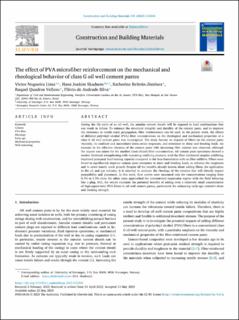| dc.contributor.author | Nogueira Lima, Victor | |
| dc.contributor.author | Skadsem, Hans Joakim | |
| dc.contributor.author | Beltrán-Jiménez, Katherine | |
| dc.contributor.author | Velloso, Raquel Quadros | |
| dc.contributor.author | Silva, Flávio de Andrade | |
| dc.date.accessioned | 2023-11-20T08:02:18Z | |
| dc.date.available | 2023-11-20T08:02:18Z | |
| dc.date.created | 2023-05-23T18:49:27Z | |
| dc.date.issued | 2023 | |
| dc.identifier.citation | Lima, V. N., Skadsem, H. J., Beltrán-Jiménez, K., Velloso, R. Q., & de Andrade Silva, F. (2023). The effect of PVA microfiber reinforcement on the mechanical and rheological behavior of class G oil well cement pastes. Construction and Building Materials, 391, 131806. | en_US |
| dc.identifier.issn | 0950-0618 | |
| dc.identifier.uri | https://hdl.handle.net/11250/3103444 | |
| dc.description.abstract | During the life cycle of an oil well, the annular cement sheath will be exposed to load combinations that can result in failure. To enhance the structural integrity and ductility of the cement paste, and to improve the resistance to tensile crack propagation, fiber reinforcement can be used. In the present work, the effects of different polyvinyl alcohol (PVA) fiber concentrations on the rheological and mechanical properties of a class G oil well cement paste was investigated. The study focuses on impacts of fibers on the cement paste viscosity, its confined and unconfined stress–strain responses, and resistance to shear and bending loads. An increase in the effective viscosity of the cement paste with increasing fiber content was observed, although the impact was minor for the smallest (semi-dilute) fiber concentration. All cement paste specimens showed a modest frictional strengthening with increasing confining pressure, with the fiber reinforced samples exhibiting improved post-peak load-bearing capacity compared to the base formulation with no fiber additive. Fibers were found to significantly improve cement paste resistance to shear and bending loads, to enhance the toughness and to arrest tensile crack growth. Despite all the benefits already known about adding fibers, for application in the oil and gas industry, it is essential to evaluate the rheology of the mixture that will directly impact pumpability and placement. In this work, flow curves were measured only for concentrations ranging from 0.1% to 0.5% since the other cases approached the concentrated suspension regime with the fluid behaving like a plug. Still, the results elucidate the potential benefits of adding even a relatively small concentration of high-aspect-ratio PVA fibers to oil well cement pastes, particularly for enhancing early-age cement’s shear and bending strength. | en_US |
| dc.description.abstract | The effect of PVA microfiber reinforcement on the mechanical and rheological behavior of class G oil well cement pastes | en_US |
| dc.language.iso | eng | en_US |
| dc.publisher | Elsevier | en_US |
| dc.rights | Navngivelse 4.0 Internasjonal | * |
| dc.rights.uri | http://creativecommons.org/licenses/by/4.0/deed.no | * |
| dc.subject | Rheology | en_US |
| dc.subject | Rheology | en_US |
| dc.subject | Sement | en_US |
| dc.subject | Cementum | en_US |
| dc.title | The effect of PVA microfiber reinforcement on the mechanical and rheological behavior of class G oil well cement pastes | en_US |
| dc.type | Peer reviewed | en_US |
| dc.type | Journal article | en_US |
| dc.description.version | publishedVersion | en_US |
| dc.rights.holder | © The Authors | en_US |
| dc.subject.nsi | VDP::Petroleumsteknologi: 512 | en_US |
| dc.subject.nsi | VDP::Petroleum engineering: 512 | en_US |
| dc.source.volume | 391 | en_US |
| dc.source.journal | Construction and Building Materials | en_US |
| dc.identifier.doi | 10.1016/j.conbuildmat.2023.131806 | |
| dc.identifier.cristin | 2148844 | |
| dc.relation.project | Andre: Brasil (CAPES) – Finance Code 001 | en_US |
| dc.relation.project | Norges forskningsråd: 309295 | en_US |
| dc.source.articlenumber | 131806 | en_US |
| cristin.ispublished | true | |
| cristin.fulltext | original | |
| cristin.qualitycode | 2 | |

